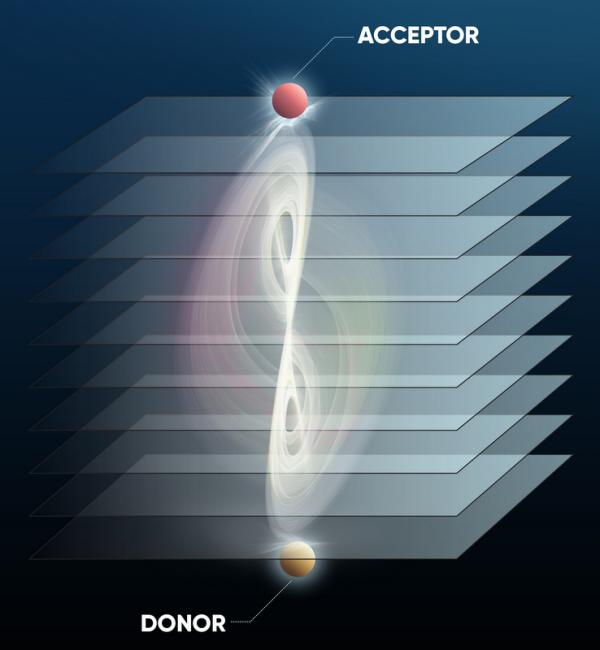
Schematic of the long-range energy transfer between donor and acceptor molecules enhanced by the metamaterial. Image Credit: Visakh Menon
Using engineered nanocomposite structures called metamaterials, a City College of New York-led research team reports the ability to measure a significant increase in the energy transfer between molecules. Reported in the journal ACS Photonics, this breakthrough breaks the Förster resonance energy transfer (FRET) distance limit of ~10-20 nanometers, and leads to the possibility of measuring larger molecular assemblies.
And since FRET is a staple technique in many biological and biophysical fields, this new development could benefit pharmaceuticals, for instance.
“Energy transfer between molecules plays a central role in phenomena such as photosynthesis and is also used as a spectroscopic ruler for identifying structural changes of molecules,” said Vinod Menon, professor of physics in City College’s Division of Science. “However, the process of energy transfer is usually limited in the distance over which it occurs, typically reaching 10 to 20 nm.”
But in the study reported by Menon’s research group in ACS Photonics, the authors demonstrate significant increase in the energy transfer distance (> 15x) – reaching ~ 160 nm. This is accomplished by using a metamaterial that undergoes a topological transition.
The present work sets the stage for the use of spectroscopic rulers for studying a wide array of larger molecular systems which has not been previously possible using standard FRET technique.
The Menon group comprised CCNY physics majors Rahul Deshmukh and Tal Galfsky (both graduate students) and Emaad Khwaja (undergraduate). Collaborators included the theory groups of Girish Agarwal (Texas A&M University) and Svend-Age Biehs (Carl von Ossietzky University, Germany). The work at CCNY was supported by the National Science Foundation’s Division of Materials Research and the U.S. Department of Energy’s Office of Basic Energy Sciences.
About The City College of New York
Since 1847, The City College of New York has provided a high quality and affordable education to generations of New Yorkers in a wide variety of disciplines. CCNY embraces its role at the forefront of social change. It is ranked #1 by the Harvard-based Opportunity Insights out of 369 selective public colleges in the United States on the overall mobility index. This measure reflects both access and outcomes, representing the likelihood that a student at CCNY can move up two or more income quintiles. In addition, the Center for World University Rankings places CCNY in the top 1.2% of universities worldwide in terms of academic excellence. More than 16,000 students pursue undergraduate and graduate degrees in eight professional schools and divisions, driven by significant funded research, creativity and scholarship. CCNY is as diverse, dynamic and visionary as New York City itself. View CCNY Media Kit.